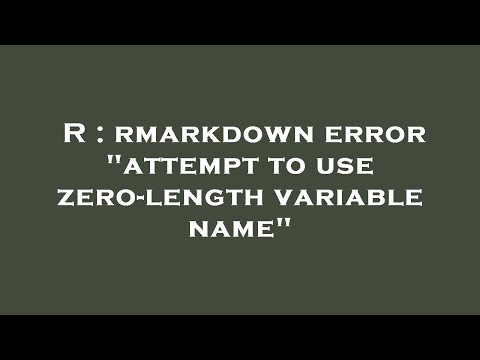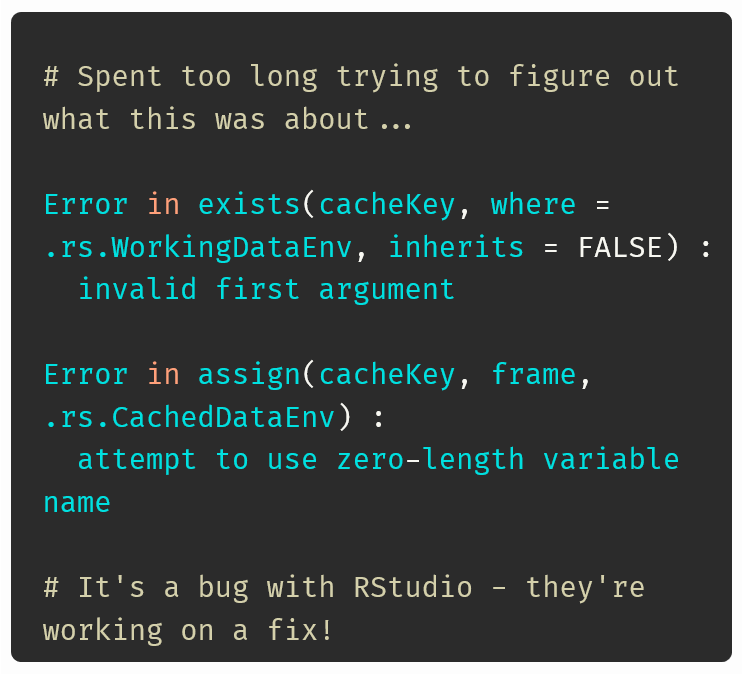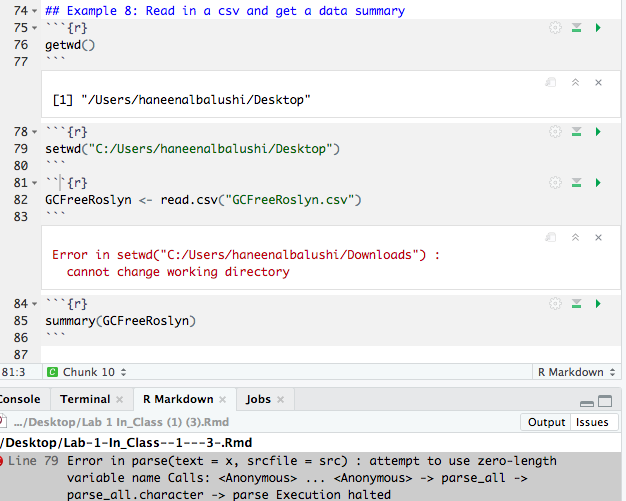Attempt To Use Zero-Length Variable Name
In the world of programming, variable names play a crucial role in writing clean, readable, and maintainable code. They provide a way to identify and reference values stored in memory, aiding programmers in understanding the purpose and functionality of different parts of their code. However, there are instances where developers may attempt to use zero-length variable names, which can have significant risks and implications.
Definition of Zero-Length Variable Name
Before delving into the risks and implications, it is important to understand what zero-length variable names entail. In programming, variable names are identifiers that are used to store data values. A zero-length variable name refers to a variable name that consists of no characters or symbols. It is essentially an empty name, devoid of any meaning or purpose. This is often done intentionally by developers, but it can have consequences on the readability and maintainability of the code.
Risks and Implications of Using Zero-Length Variable Names
Using zero-length variable names can introduce potential confusion and difficulty in code readability. When reading or collaborating on code, it is crucial for developers to understand the purpose and functionality of different variables. With zero-length variable names, it becomes difficult to grasp the intent behind a variable, leading to confusion and potentially introducing errors in the code.
Furthermore, the increased likelihood of introducing bugs and errors is another significant risk. Without clear and meaningful variable names, it becomes easier to misuse or misunderstand the values stored in the variables. This can result in logical errors, data corruption, or unexpected behavior, making code maintenance and troubleshooting more challenging.
Challenges in maintaining and troubleshooting code is yet another implication of using zero-length variable names. When code needs to be updated or fixed, developers often rely on the names and comments associated with the variables to understand their purpose, scope, and dependencies. With zero-length variable names, this crucial information is lost, adding complexity and time to the debugging process.
Best Practices for Variable Naming in Programming
To avoid the risks and challenges associated with zero-length variable names, it is important to follow best practices for variable naming in programming. Here are some recommendations:
1. Choosing meaningful and descriptive variable names: Opt for names that accurately describe the purpose or content of the variable. This makes the code more readable and understandable for other developers.
2. Following established naming conventions in the programming language: Most programming languages have recommended naming conventions. Adhering to these conventions ensures that your code remains consistent and easily comprehensible for fellow programmers.
3. Utilizing appropriate length and structure for variable names: While it may be tempting to use extremely concise names, it is essential to strike a balance between brevity and descriptiveness. Long, convoluted names can be just as harmful as zero-length names, so opt for names that are concise yet informative.
Alternatives to Using Zero-Length Variable Names
Instead of resorting to zero-length variable names, consider these alternatives:
1. Utilizing single-character variable names for specific purposes: Single-character names can be acceptable in certain scenarios, such as loop counters or mathematical formulas. However, always provide comments or context to explain their purpose.
2. Employing abbreviations or acronyms to represent longer variable names: When variable names are long or verbose, consider using abbreviations or acronyms that convey the essential information. Again, provide comments to clarify the meaning if necessary.
3. Considering the use of constants or literals when appropriate: Instead of using zero-length variable names to store temporary or constant values, utilize constants or literals directly in the code. This eliminates the need for unnecessary variables and improves code clarity.
Tools and Techniques for Ensuring Strong Variable Naming
To enforce strong variable naming practices, programmers can employ the following tools and techniques:
1. Utilizing code editors or Integrated Development Environments (IDEs) with built-in syntax highlighting and suggestions: IDEs like Visual Studio Code, IntelliJ, or Eclipse often provide suggestions and syntax highlighting that aid in selecting appropriate variable names.
2. Utilizing code analysis and linting tools to enforce naming conventions: Code analysis tools such as ESLint, SonarQube, or pylint can be configured to check for naming conventions and provide warnings or error messages if violations are detected.
3. Conducting regular code reviews to identify and address variable naming issues: Code reviews serve as an opportunity to catch potential issues, including poor variable naming practices. A collaborative approach can lead to clearer and more consistent code across the project.
Examples of Correct Variable Naming Practices
To illustrate proper variable naming practices, consider the following examples:
1. Demonstrating the use of meaningful and descriptive names for variables:
– Instead of using a zero-length variable name like `x`, a more descriptive name like `numberOfStudents` or `userInput` provides better clarity.
– Naming a variable storing a person’s age as `age` or `userAge` instead of an empty name would make the code more readable.
2. Highlighting the adherence to naming conventions in different programming languages:
– In JavaScript, a variable representing the name of a company could be named `companyName`.
– Similarly, in Python, the same variable might be named `company_name` to adhere to the snake_case naming convention.
3. Showcasing the benefits of clear and consistent variable naming practices:
– Code with well-named variables is easier to understand for both the original developer and future maintainers.
– Reduced confusion and improved code readability lead to increased productivity and reduced chances of introducing bugs or errors.
Conclusion
In conclusion, attempting to use zero-length variable names in programming introduces significant risks and challenges. It compromises code readability, increases the likelihood of errors, and makes maintaining and troubleshooting code more difficult. Instead, developers should adhere to best practices for variable naming, choose meaningful and descriptive names, and utilize appropriate alternatives to zero-length names. By utilizing tools and techniques to enforce naming conventions and conducting regular code reviews, programmers can ensure strong variable naming practices.
R : Rmarkdown Error \”Attempt To Use Zero-Length Variable Name\”
Keywords searched by users: attempt to use zero-length variable name Error: attempt to apply non function, How to use R Markdown
Categories: Top 15 Attempt To Use Zero-Length Variable Name
See more here: nhanvietluanvan.com
Error: Attempt To Apply Non Function
In the realm of programming, errors are an inevitable part of the learning process. One such error that often puzzles beginners and even experienced programmers is the infamous “Error: attempt to apply non-function.” This cryptic and enigmatic error message can leave developers scratching their heads, wondering what went wrong. In this article, we will delve into this error, explore its causes, and provide solutions to help you conquer this programming hurdle.
What is the “Error: attempt to apply non-function”?
The “Error: attempt to apply non-function” message is often encountered when a program attempts to invoke a non-function object as if it were a function. Essentially, it signifies that a variable or expression, which should be a function, is being used as if it were capable of executing code. This error can occur in various programming languages, including but not limited to R, Python, and JavaScript.
Causes of the error
Understanding the causes behind the “Error: attempt to apply non-function” is crucial to resolving it effectively. Below are some common scenarios that can trigger this error:
1. Incorrect variable assignment: This error can arise when a variable is unintentionally assigned a value that is not a function. For example, assuming “myVariable” should hold a function, assigning it an integer value will lead to this error.
2. Misusing built-in functions: Certain built-in functions have specific data type requirements for their arguments. Supplying inappropriate or incompatible arguments can lead to the “Error: attempt to apply non-function.” It is crucial to ensure that the correct data types are used when invoking built-in functions.
3. Accidental overwriting of functions: If a variable name used for a function call is subsequently assigned a non-function value, attempting to invoke the variable as a function will cause this error. This commonly occurs when variables are mistyped or inadvertently reassigned.
Solutions to fix the error
Now that we’ve explored the causes, let’s delve into possible solutions to resolve the “Error: attempt to apply non-function”:
1. Check variable assignments: Review the variable assignments within your code to verify that variables that are meant to be functions are assigned appropriately. Double-check the data types and ensure that no accidental overwriting or reassignments have occurred.
2. Review function definitions: If the error arises when invoking a user-defined function, revisit the function definition. Ensure that the function is correctly defined and that it is not being reassigned with a non-function value at any point in the code.
3. Debug built-in functions: If the error occurs when invoking a built-in function, examine the documentation of the function to identify the correct data types for its arguments. Validate that the inputs provided to the function adhere to these requirements.
4. Debug statements: Adding debug statements at crucial points in your code can help trace the error back to its source. Printing out variable values or using a debugger can shed light on when and where a non-function is being applied incorrectly.
5. Code review: Consider seeking assistance from a colleague or utilizing online programming forums for a fresh set of eyes on your code. Sometimes, a second perspective can uncover subtle mistakes or provide alternative insights that lead to a solution.
FAQs
Q1. Can non-function objects ever be used as functions?
A1. No, non-function objects cannot be used as functions. Functions are specific entities in programming, capable of executing operations when called with appropriate inputs. Non-functional objects lack this capability.
Q2. Why doesn’t the error message explicitly state the cause?
A2. Error messages are usually designed to be general and reusable across different scenarios. As a result, they often lack specific context to pinpoint the exact cause. It is up to the programmer to analyze the surrounding code and variables to identify the specific issue.
Q3. Is there a way to prevent this error from occurring in the first place?
A3. By following best practices such as assigning variables correctly and diligently checking function definitions, programmers can reduce the likelihood of encountering this error. Additionally, frequent code testing and debugging can help catch issues before they arise.
Conquering the “Error: attempt to apply non-function” can be a challenging but rewarding task. By understanding its causes, reviewing your code meticulously, and applying the suggested solutions, you will be equipped to tackle this error head-on. Remember, persistence and attention to detail are key when unraveling such programming mysteries.
How To Use R Markdown
R Markdown is a powerful tool that allows you to create dynamic reports, documents, and presentations using the R programming language. This handy package integrates text, code, and output in a single document, making it easier for researchers, data analysts, and scientists to share their work.
In this article, we will delve into the details of R Markdown, exploring its features and functionality, and providing you with a step-by-step guide on how to use it effectively. So, without further ado, let’s get started!
Getting Started with R Markdown
To begin using R Markdown, you need to have R and RStudio installed on your computer. If you haven’t done so already, head over to the R website (https://www.r-project.org/) and download R. Once that is complete, visit the RStudio website (https://www.rstudio.com/) and download RStudio, which is an integrated development environment (IDE) specifically designed for R.
After installing R and RStudio, open RStudio and create a new R Markdown document by clicking on “File” in the menu bar, then selecting “New File” and finally “R Markdown.” You can choose either a blank template or use a predefined template to get started quickly.
Document Formatting and Structure
R Markdown documents are written using a combination of plain text and R code chunks. The plain text is written in Markdown, a simple formatting syntax that allows you to control the appearance of your document. You can use Markdown to create headings, apply formatting styles to text, include images, create lists, and much more.
R code chunks are enclosed within triple backticks (““`”) and can be inserted throughout the document wherever you want to execute some R code. By default, the output of the code chunks will be displayed immediately after the code. However, you can control the display of the output by specifying options within the chunk.
Running Code Chunks
To run the R code chunks in your R Markdown document, you can either click the “Knit” button in the RStudio toolbar or use the keyboard shortcut “Ctrl + Shift + K” (Windows) or “Cmd + Shift + K” (Mac). The results of the code execution will be displayed in the output sections of your document.
You can also run individual code chunks by placing your cursor within the chunk and using the keyboard shortcut “Ctrl + Enter” (Windows) or “Cmd + Enter” (Mac). This is particularly useful for testing and debugging your code.
Intermediate Formatting
R Markdown offers various options for intermediate formatting to enhance the appearance of your document. By using HTML, CSS, and LaTeX, you can customize the layout, insert mathematical equations, create tables, and more.
For example, to insert a mathematical equation, you can use the LaTeX syntax by enclosing the equation within dollar signs (“$”). R Markdown will automatically render the equation using the MathJax library. Writing inline equations is as simple as surrounding the equation with single dollar signs (“\$”).
FAQs
Q: Can R Markdown be used for generating different types of output?
A: Yes, R Markdown can generate various types of output, including HTML, PDF, Word, and PowerPoint presentations. You can specify the desired output format by setting the “output” field in the YAML header of your R Markdown document.
Q: Can I include external data in R Markdown documents?
A: Absolutely! R Markdown allows you to import data from external sources such as CSV, Excel, or databases. You can load the data into R code chunks and use it for analysis, visualization, or reporting purposes.
Q: Can I collaborate with others using R Markdown?
A: Yes, R Markdown makes collaboration easy. You can share your R Markdown documents with others, and they can easily reproduce your analyses by simply knitting the document. Moreover, you can use version control systems like Git to manage changes and collaborate with others efficiently.
Q: Are there any shortcuts available for faster coding in R Markdown?
A: RStudio provides several shortcuts to speed up your coding in R Markdown. For instance, you can quickly insert code chunks by pressing “Ctrl + Alt + i” (Windows) or “Cmd + Option + i” (Mac). Additionally, you can use the “Tab” key to autocomplete code, navigate between chunks, and more.
Q: Is it possible to use custom templates in R Markdown?
A: Yes, R Markdown allows you to use custom templates to achieve a more personalized document style. You can create your own templates or utilize existing ones shared by the R community.
Conclusion
R Markdown is a versatile tool that facilitates the creation of reproducible reports and documents by seamlessly combining text, code, and output. By following the steps outlined in this article, you can get started with R Markdown and produce professional-looking documents in no time.
Remember to explore the extensive capabilities of R Markdown, experiment with different formatting options to customize your documents, and make use of the R Markdown community, which provides numerous resources, tutorials, and templates to help you on your journey. Happy coding!
Images related to the topic attempt to use zero-length variable name

Found 39 images related to attempt to use zero-length variable name theme















Article link: attempt to use zero-length variable name.
Learn more about the topic attempt to use zero-length variable name.
- Chapter 3 R & RStudio, RMarkdown | R for Excel Users
- Fixing the R Error: attempt to use zero-length variable name
- rmarkdown error “attempt to use zero-length variable name”
- Fix: Error: Attempt to use zero-length variable name
- [Solved]-Error: attempt to use zero-length variable name-R
- Error : attempt to use zero-length variable name : r/rstats – Reddit
- attempt to use zero-length variable name : R-904 – YouTrack
- rename() and error – attempt to use zero-length variable name …
- RMarkdown notebook error – Kaggle
- attempt to use zero-length variable name – RStudio Community
See more: nhanvietluanvan.com/luat-hoc